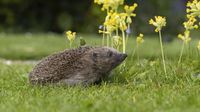As the chill of winter fades and spring steps in, hedgehogs are finally emerging from their hibernation, starting around mid-March. The first to wake are the male hedgehogs, soon followed by females in early April, and then the young hedgehogs. But as they reappear in gardens, many wonder: do these adorable creatures need our help?
According to Heike Philipps, the chairperson of the nonprofit organization Pro Igel e. V., the answer is a resounding yes. "The spaces hedgehogs inhabit today are neither ideal nor large enough to provide ample natural food, water, or shelter. A single hedgehog requires 2,000 square meters of well-vegetated area—not just lawn—to find enough to eat," she explains, emphasizing the importance of suitable habitats for these animals.
During their hibernation period, hedgehogs lose a significant portion of their body weight, approximately 20 to 40 percent, equating to about one to two grams daily, as reported in the Igel-Bulletin. This weight loss underscores the urgency of finding nutritious resources as they wake up gasping for food.
So how can garden owners help? Philipps offers a host of helpful suggestions. One key recommendation is to create barrier-free transitions between gardens. "It’s beneficial to create openings of at least ten by ten centimeters on each property’s side," she notes, allowing hedgehogs to easily navigate between spaces. Additionally, providing drinking water on the ground level is essential. It’s a critical resource that can help hydrate these creatures after their lengthy slumber.
Furthermore, setting up a feeding station for two or three weeks after they wake can significantly assist hedgehogs. Philipps suggests offerings like well-cooked scrambled eggs or high-quality wet cat food, as these food options help provide the necessary nutrients they require post-hibernation.
Despite the excitement of spring gardening, it's wise to hold off on extensive yard work right away. Philipps advises limiting cleanup efforts since there can still be cold nights during which hedgehogs may return to their winter nests. She highlights the importance of being patient and cautious to ensure that these half-asleep animals get the time they need.
For those looking to improve their gardens for hedgehogs beyond spring, there are various long-term changes one can make. Transforming part of the lawn into a flower meadow can create an attractive habitat. Moreover, constructing Benjes hedges—piles of branches designed to foster wildlife habitat—or creating small piles of dead wood and stones with cavities serve both as shelter and foraging spots.
Constructing a beetle cellar is another effective way to support hedgehogs. These beetle homes provide a nutritious food source that hedgehogs will be able to find while foraging. By making just a few adjustments, garden owners can make their spaces significantly friendlier to wildlife.
As spring fully unfolds, the challenge remains both for garden enthusiasts and for hedgehogs seeking support. Through mindful gardening and a willingness to adapt, we can help bridge the gap for these charming creatures as they emerge from their long winter nap. The responsibility to nurture local wildlife rests with all of us, transforming our gardens into havens for hedgehogs and a variety of other wildlife.
This spring, remember that every little effort counts in creating a welcoming environment. Whether it’s making minor adjustments to garden layouts or providing food and water, our actions can have a critical impact on the lives of hedgehogs returning from hibernation.





